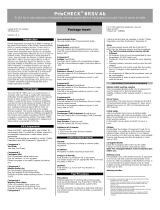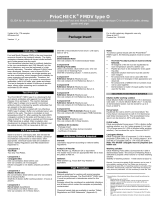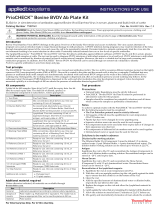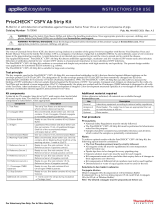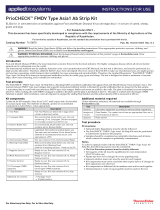Page is loading ...

PrioCHECK
®
PPV Ab
ELISA for in vitro detection of antibodies directed against Porcine Parvo Virus in serum of pigs
2 plate kit for 176 samples
©Prionics AG
Version 1.1_e
For in-vitro veterinary diagnostic use only
Store at 5±3°C
Product No.: 7588981
Introduction
Porcine Parvovirus (PPV) is a small single-stranded
DNA virus, belonging to the family of the parvoviridae.
The virus is a ubiquitous infectious agent of pigs
causing reproductive failures in pig herds, and is of
economic concern to pig breeders worldwide. The
virus is capable of crossing the placenta. The conse-
quences of an infection with PPV are dependent on
the immune status of the dam on the stage of gesta-
tion at which infection occurs. In the non-immune dam,
PPV infections, which occur prior to 35 days gestation,
can lead to embryonic death. After approximately 70
days, when fetuses are immunocompetent, the porcine
fetus is capable of mounting an immune response by
producing antibodies to PPV and may survive infec-
tion. This usually results in birth of healthy, serologi-
cally positive piglets.
The PrioCHECK
®
PPV Ab detects specific antibodies
as early as seven days after primary infection. The
antibody titer reaches a plateau at approximately 10
days after infection.
By titration of paired serum samples, collected from a
herd at an interval of several weeks, the infection
status can be monitored. Based on this information,
decisions can be made on control of the infection by
vaccination.
Test Principle
The PrioCHECK
®
PPV Ab ELISA is a single dilution
test. Serum samples are tested in a 1:5 dilution.
Dilutions of test serum are pre-incubated with PPV
antigen. During this incubation, specific antibodies, if
present, will form an immune complex with the anti-
gen. After this pre-incubation, the mixture is trans-
ferred to an antibody-coated test plate. During a
subsequent incubation in the test plate, free PPV
antigen in the mixture is bound to the antibody-coated
well, whereas antigen which previously has formed an
immune complex with antibodies in the test serum (=
blocked antigen) is not bound. After washing away
unbound reagents, conjugate is added and this will
react with the bound antigen. After incubation, wells
are washed again and Chromogen (TMB) Substrate is
added.
Finally, color development is stopped and measured at
a wavelength of 450 nm.
Kit Components
Store kit at 5±3°C until expiry date. See kit label for
actual expiry date. The shelf life of diluted, opened or
reconstituted components is noted below, when
appropriate. Chemical hazard data are available in
section “Safety Regulations and R&S Statements”
(Appendix II).
Component 1
Test Plate
Two strip Test Plates.
Component 2
Conjugate (30x)
(30x concentrated, dilute before use)
One vial contains 1.5 ml Conjugate.
Diluted conjugate is not stable, prepare just before
use.
Component 3
Dilution Buffer (5x)
(5x concentrated, dilute before use)
One vial contains 60 ml Dilution Buffer.
Shelf life of dilution buffer working solution: 5 hours at
22±3°C.
Component 4
Washing Fluid (200x)
(200x concentrated, dilute before use)
One vial contains 60 ml Washing Fluid.
Shelf life of washing solution: 1 week at 22±3°C.
Component 5
Demineralized Water
One vial contains 10 ml Demineralized Water.
Component 6
Horse Serum (lyophilized)
One vial contains 3.5 ml lyophilized Horse Serum.
Shelf life of reconstituted horse serum: until expiry
date at -20°C.
Component 7
Antigen (lyophilized)
Two vials, each contains 6.0 ml lyophilized Antigen.
Shelf life of reconstituted antigen: in aliquots until
expiry date at -20°C.
Component 8
Reference Serum 1 (Ready-to-use)
One vial contains 1.0 ml Reference Serum 1 (positive
control).
Component 9
Reference Serum 2 (Ready-to-use)
One vial contains 1.0 ml Reference Serum 2 (negative
control).
Component 10
Chromogen (TMB) Substrate (Ready-to-use)
One vial contains 60 ml Chromogen (TMB)
Substrate.
Component 11
Stop Solution (Ready-to-use)
One vial contains 60 ml Stop Solution.
Additional Kit Contents:
- Package Insert
- 1 lid to cover the plate during incubation
- Certificate of analysis
Additional Material Required
General:
Laboratory equipment according to national safety
regulations.
Dummy plates:
Dummy plates for diluting of test sera with the recon-
stituted antigen. We advice U-bottom shaped plates
(Greiner, art. nr. 6501101). However, also other non
binding plates or tubes can be used.
Incubation:
Microplate Incubator (reaching at least 50°C).
Analysis of Results:
Plate Reader e.g. Multiscan EX or equivalent.
The reader has to have an appropriate filter set to read
the plates at 450 nm.
Optional:
Plate washer e.g. Tecan EIA Tray Washer or
equivalent.
Test Procedure
Precautions
National guidelines for working with animal samples
must be strictly followed. The PrioCHECK
®
PPV Ab
must be performed in laboratories suited for this
purpose.
Samples should be considered as potentially infectious
and all items which contact the samples as potentially
contaminated.
Chemical hazard data are available in section “Safety
Regulations and R&S Statements” (Appendix II).
Notes
To achieve optimal results with the PrioCHECK
®
PPV
Ab, the following aspects must be considered:
The Test Procedure protocol must be strictly
followed.
All reagents of the kit must be equilibrated to room
temperature (22±3°C) before use.
Pipette tips have to be changed for every pipetting
step.
Separate solution reservoirs must be used for each
reagent.
Kit components must not be used after their expiry
date or if changes in their appearance are ob-
served.
Kit components of different kit lot numbers must not
be used together.
Demineralized or water of equal quality must be
used for the test.
SOLUTIONS TO BE MADE IN ADVANCE
Dilution buffer working solution
The concentrated Dilution Buffer (5x) (Component 3)
must be diluted 1/5 in demineralized water.
Stability of dilution buffer working solution: 5 hours at
22±3°C.
Horse Serum
Reconstitute
1
the Horse Serum (Component 6) with
3.5 ml Demineralized Water (Component 5). After
reconstitution, store at -20°C until expiry date.
Conjugate buffer
To perform a test with two strips add to 1.9 ml dilution
buffer working solution, 0.1 ml reconstituted horse
serum (final concentration of horse serum is 5% (v/v)).
Unused conjugate buffer can be stored at 5±3°C for up
to 24 hours.
Conjugate dilution
Dilute the Conjugate (30x) (Component 2) 1/30 with
conjugate buffer. Prepare 1.8 ml to perform a test with
two strips.
Note: The diluted conjugate must be prepared just
before use.
Antigen
Reconstitute
1
the Antigen (Component 7) with 6 ml
dilution buffer working solution. For partial use of the
test kit the vial reconstituted antigen should be divided
in 1.0 ml aliquots (for a maximum of 6 test runs per
plate). Avoid multiple freezing and thawing and store
the aliquots in small vials at -20°C.
1 Reconstitution of lyophilized reagents should be performed as follows:
- Equilibrate the vials to 22±3°C.
- With the vial in an upright position, tap the vial gently against the
worktop to ensure that the content is on the bottom of the vial.
- Open the vial.
- Add the required amount of demineralized water.
- Replace the stopper on the vial and gently rotate the vial so that any
remaining dry material will be dissolved.
- Allow the lyophilized material to stand for 15 minutes at 22±3°C.
- Occasionally gently invert the vial (formation of foam should be
avoided).
Package Insert

PrioCHECK
®
PPV Ab
Washing solution
The Washing Fluid (200x) (Component 4) must be
diluted 1/200 in demineralized water and is sufficient
for a final volume of 12 liters of washing solution.
Stability of washing solution: 1 week stored at 22±3°C.
Note: Commercially available ELISA washers can be used. If
not available, washing of the plates can be done by hand by
dispensing 200 - 300 µl of washing solution to all wells of the
plate. Subsequently, empty the plate and repeat as many times
as prescribed. It is not necessary to soak the plate. Tap the
plate firmly after the last washing.
PRE-INCUBATION OF TEST SAMPLES
AND ANTIGEN
1.1 Mix 96 µl dilution buffer working solution with 24
µl Reference Serum 1 (Component 8) and 120
µl reconstituted antigen.
1.2 Mix 96 µl dilution buffer working solution with 24
µl Reference Serum 2 (Component 9) and 120
µl reconstituted antigen.
1.3 Mix 12 µl of each serum sample with 48 µl
dilution buffer working solution and 60 µl recon-
stituted antigen.
1.4 Incubate for 60±5 minutes at 37±1°C.
INCUBATION IN TEST PLATE
2.1 Label each strip of the Test Plate (Component
1) with a marker pen.
2.2 Dispense 100 µl of dilution buffer working
solution to wells A1 and B1.
2.3 Dispense 50 µl of dilution buffer working solu-
tion to wells C1 and D1.
2.4 Add 50 µl of reconstituted antigen to wells C1
and D1 and mix.
2.5 Dispense 100 µl of reference serum 1 - antigen
mixture to wells E1 and F1.
2.6 Dispense 100 µl of reference serum 2 - antigen
mixture to wells G1 and H1.
2.7 Dispense 100 µl of the test sample - antigen
mixture to the remaining wells.
2.8 Seal the Test Plate and incubate for 120±5
minutes at 37±1°C.
INCUBATION WITH CONJUGATE
3.1 Empty the Test Plate and wash the plate 6 times
with 200 to 300 µl washing solution. Tap the
plate firmly after the last wash cycle.
3.2 Dispense 100 µl of diluted conjugate to all wells.
3.3 Seal the Test Plate and incubate for 60±5 min-
utes at 37±1°C.
INCUBATION WITH CHROMOGEN (TMB) SUB-
STRATE
4.1 Empty the Test Plate after the incubation period
and wash the plate 6 times with 200 to 300 µl
washing solution. Tap the plate firmly after the
last wash cycle.
4.2 Dispense 100 µl of Chromogen (TMB) Substrate
(Component 10) to all wells.
4.3 Incubate the plate for 15 minutes at 22±3°C.
4.4 Add 100 µl of Stop Solution (Component 11) to
all wells.
4.5 Mix the content of the wells prior to measuring.
Note: Start the addition of Stop Solution 15 minutes after the
first well was filled with Chromogen (TMB) Substrate. Add the
Stop Solution in the same order and the same pace as the
Chromogen (TMB) Substrate was dispensed.
READING OF THE TEST AND CALCULATING THE
RESULTS
5.1 Measure the optical density (OD) of the wells at
450 nm within 15 minutes after color develop-
ment has been stopped.
5.2 Calculate the mean OD
450
value of wells A1 and
B1 (=OD
450
blank).
5.3 Calculate the corrected OD
450
value of reference
sera 1, 2 and of the serum samples by subtract-
ing the mean OD
450
blank.
5.4 Calculate the mean of the corrected OD
450
of
wells C1 and D1 (=OD
450
max).
5.5 The percentage inhibition (PI) is calculated
according to the following formula:
Note: The corrected OD
450
of all samples is expressed
as percent inhibition (PI) relative to the corrected mean
OD
450
max.
corrected OD
450
test sample
PI = 100- ---------------------------------------- x 100
corrected OD
450
max
RESULT INTERPRETATION
Validation criteria
6.1 The mean OD
450
blank (wells A1 and B1) should
be <0.300.
6.2 The corrected OD
450
max (wells C1 and D1)
must be >1.000.
6.3 The PI of Reference Serum 1 (positive control)
must be >50%.
6.4 The PI of Reference Serum 2 (negative control)
must be <50%.
6.5 Not meeting any of these criteria is reason to
discard the results of that specific test plate.
Note: If the corrected OD
450
max is below 1.000 possibly the
Chromogen (TMB) Substrate is too cold. In that case warm the
solution to 22±3°C or incubate up to 30 minutes.
If the corrected mean OD
450
max is above 2.000 a shorter
incubation period with the Chromogen (TMB) Substrate is
recommended.
Interpretation of the percentage inhibition
PI = ≥50%
Test sample is positive for PPV specific antibodies.
PI = <50%
Test sample is negative for PPV specific antibodies.
Appendix I
Notice
This manual is believed to be complete and accurate
at the time of publication. In no event shall Prionics AG
be liable for incidental or consequential damage in
connection with or arising from the use of this manual.
Liability
Prionics AG warrants its products will meet their
applicable published specification when used in
accordance with their applicable instructions and
within the declared products life time. Prionics AG
makes no other warranty, expressed or implied. There
is no warranty of merchantability or fitness for a par-
ticular purpose. The warranty provided herein and the
data, specifications and descriptions of Prionics AG
products appearing in Prionics AG published cata-
logues and product literature may not be altered
except by express written agreement signed by an
officer of Prionics AG. Representation, oral or written,
which are inconsistent with this warranty or such
publications are not authorized and if given, should not
be relied upon.
In the event of a breach of the foregoing warranty,
Prionics AG’s sole obligation shall be to repair or
replace, at its option, the applicable product or part
thereof, provided the customer notifies Prionics AG
promptly of any such breach. If after exercising rea-
sonable efforts, Prionics AG is unable to repair or
replace the product or part, then Prionics AG shall
refund to the customer all monies paid for such appli-
cable product or part.
Prionics AG shall not be liable for consequential,
incidental, special or any other indirect damages
resulting from economic loss or property damage
sustained by any customer from the use of its prod-
ucts.
Prionics AG and Prionics Lelystad B.V. are ISO
9001:2000 certified companies.
Appendix II
Safety Regulations and R&S Statements
National Safety Regulations must be strictly fol-
lowed.
Component 1
Test Plate
Hazard Code: This product is not classified according
to EU regulations.
Component 2
Conjugate (30x)
Hazard Code: This product is not classified according
to EU regulations.
Component 3
Dilution Buffer (5x)
Hazard Code: This product is not classified according
to EU regulations.
Component 4
Washing Fluid (200x)
Hazard Code: This product is not classified according
to EU regulations.
Component 5
Demineralized Water
Hazard Code: This product is not classified according
to EU regulations.
Component 6
Horse Serum (lyophilized)
Hazard Code: This product is not classified according
to EU regulations.
Component 7
Antigen (lyophilized)
Hazard Code: This product is not classified according
to EU regulations.
Component 8
Reference Serum 1 (Ready-to-use)
Hazard Code: This product is not classified according
to EU regulations.
Component 9
Reference Serum 2 (Ready-to-use)
Hazard Code: This product is not classified according
to EU regulations.
Component 10
Chromogen (TMB) Substrate (Ready-to-use)
Hazard Code: This product is not classified according
to EU regulations.
Component 11
Stop Solution (Ready-to-use)
Hazard Code: R35: Causes severe burns.
S26: In case of contact with eyes, rinse immediately
with plenty of water and seek medical advice.
S36/37/39: Wear suitable protective clothing, gloves
and eye/face protection.
S45: In case of accident or if you feel unwell, seek
medical advice immediately (show the label on vial).
Appendix III
References
(1) F. Westenbrink, M.A. Veldhuis and J.M.A. Brinkhof
Journal of Virological Methods, 23 (1989) 169-178.
Contact
Prionics Lelystad B.V.
Platinastraat 33
P.O. Box 2271
NL-8203 AG Lelystad
The Netherlands
Tel. +31 320 714000
Fax +31 320 714029
Prionics AG
Wagistrasse 27a
CH-8952 Schlieren-Zurich
Switzerland
Tel. +41 44 200 2000
Fax +41 44 200 2010
www.prionics.com
For our distribution network, please refer to
www.prionics.com
/
